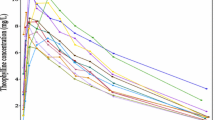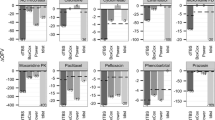Abstract
The precision of pharmacokinetic parameter estimates from several least squares parameter estimation methods are compared. The methods can be thought of as differing with respect to the way they weight data. Three standard methods, Ordinary Least Squares (OLS-equal weighting), Weighted Least Squares with reciprocal squared observation weighting [WLS(y−2)], and log transform OLS (OLS(ln))-the log of the pharmacokinetic model is fit to the log of the observations-are compared along with two newer methods, Iteratively Reweighted Least Squares with reciprocal squared prediction weighting (IRLS,(f−2)), and Extended Least Squares with power function “weighting” (ELS(f−ξ)-here ξ is regarded as an unknown parameter). Tne values of the weights are more influenced by the data with the ELS(f−ξ) method than they are with the other methods. The methods are compared using simulated data from several pharmacokinetic models (monoexponential, Bateman, Michaelis-Menten) and several models for the observation error magnitude. For all methods, the true structural model form is assumed known. Each of the standard methods performs best when the actual observation error magnitude conforms to the assumption of the method, but OLS is generally least perturbed by wrong error models. In contrast, WLS(y−2) is the worst of all methods for all error models violating its assumption (and even for the one that does not, it is out performed by OLS(ln). Regarding the newer methods, IRLS(f−2) improves on OLS(ln), but is still often inferior to OLS. ELS(f−ξ), however, is nearly as good as OLS (OLS is only 1–2% better) when the OLS assumption obtains, and in all other cases ELS(f−ξ) does better than OLS. Thus, ELS(f−ξ.
Similar content being viewed by others
References
S. L. Beal. Adaptive M estimation with independent not identically distributed data. Ph.D. dissertation, University of California, Los Angeles, 1974.
C. C. Peck, S. L. Beal, L. B. Sheiner, and A. J. Nichols. Extended least squares nonlinear regression: A possible solution to the choice of weight problem in analysis of individual pharmacokinetic data.J. Pharmacokin. Biopharm. 12:545–558 (1984).
L. B. Sheiner and S. L. Beal. Evaluation of methods for estimating population pharmacokinetic parameters. I. Michaelis-Menten model; routine clinical pharmacokinetic data.J. Pharmacokin. Biopharm. 8:553–571 (1980).
L. B. Sheiner and S. L. Beal. Evaluation of methods for estimating population pharmacokinetic parameters. II. Biexponential model; experimental pharmacokinetic data.J. Pharmacokin. Biopharm. 9:635–651 (1981).
L. B. Sheiner and S. L. Beal. Evaluation of methods for estimating population pharmacokinetic parameters. III. Monoexponential model: routine clinical pharmacokinetic data.J. Pharmacokin. Biopharm. 11:303–319 (1983).
G. E. P. Box and W. J. Hill. Correcting inhomogeneity of variance with power transformation weighting.Technometrics 16:385–389 (1974).
D. J. Pritchard, J. Downie, and D. W. Bacon. Further consideration of heteroscedasticity in fitting kinetic models.Technometrics 19:227–236 (1977).
P. M. Reilly and G. E. Blau. A method for linear or nonlinear parameter estimation when the error variance depends on the magnitude of the quantity being measured. 6th Int. Congress of Chemical Engineering, Chemical Equipment Design and Automation, Praha, Czechoslovakia, August 21–25, pp. 1–10 (1978).
N. P. Jewell and G. M. Raab. Difficulties in obtaining consistent estimators of variance parameters.Biometrika 68:221–226 (1981).
D. J. Finney and P. Phillips. The form and estimation of a variance function, with particular reference to radioimmunoassay.Appl. Statistics 26:312–320 (1977).
G. M. Raab. Estimation of a variance function, with application to immunoassay.Appl. Statistics 30:32–50 (1981).
P. J. Bickel and K. A. Doksum.Mathematical Statistics: Basic Ideas and Selected Topics. Holden-Day, Inc., San Francisco, 1977, pp. 99.
B. Box and M. Muller. A note on the generation of random normal deviates.Ann. Math. Statisti. 29:610–611 (1958).
P. Lewis, A. Goodman, and J. Miller. A pseudo random number generator for the system 360.IBM Systems J. 8:136–146 (1969).
D. W. Marquardt. An algorithm for least-sauares estimation of nonlinear parameters.SIAM J. 11:431–441 (1963).
L. B. Sheiner and S. L. Beal. Some suggestions for measuring predictive performance.J. Pharmacokin. Biopharm. 9:502–512 (1981).
G. L. Atkins. Weighting functions and data truncation in the fitting of multi-exponential functions.Biochem. J. 138:125–127 (1974).
J. Myhill. Investigation of the effect of data error in the analysis of biological tracer data from 3 compartmental systems.J. Theor. Biol. 23:218–231 (1968).
J. Myhill. Investigation of the effect of data error in the analysis of biological tracer data.Biophys. J. 7:903–910 (1967).
A. Cornish-Bowden and R. Eisenthal. Statistical considerations in the estimation of enzyme kinetic parameters by the direct linear plot and other methods.Biochem. J. 139:721–730 (1974).
W. R. Porter and W. F. Trager. Improved non-parametric statistical methods for the estimation of Michaelis-Menten kinetic parameters by the direct linear plot.Biochem. J. 161:293–302 (1977).
W. H. Shelver and F. F. Farris. Nonparametric pharmacokinetic calcuiations: One-compartment open model.J. Pharm. Sci. 72:1218–1221 (1983).
A. Cornish-Bowden and L. Endrenyi. Fitting of enzyme kinetic data without prior knowledge of weights.Biochem. J. 193:1005–1008 (1981).
D. Rodbard, R. H. Lenox, L. Wray, and D. Ramseth. Statistical characterization of the random errors in the radioimmunoassay dose-response variable.Clin. Chem. 22:350–358 (1976).
Author information
Authors and Affiliations
Additional information
This work supported by NIH Grants GM 26676 and GM 26691.
Rights and permissions
About this article
Cite this article
Sheiner, L.B., Beal, S.L. Pharmacokinetic parameter estimates from several least squares procedures: Superiority of extended least squares. Journal of Pharmacokinetics and Biopharmaceutics 13, 185–201 (1985). https://doi.org/10.1007/BF01059398
Received:
Revised:
Published:
Issue Date:
DOI: https://doi.org/10.1007/BF01059398




